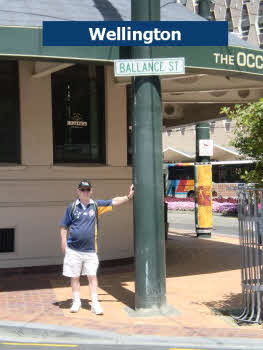
Ballypitmave’s famous son
THE DIGGER

Gabe McAreavy at Ballance Street, Wellington, New Zealand in 2008 is seeking relatives who may be closer to home.
In the early 1940’s a New Zealand born correspondent writing in the Belfast Telegraph, related his experience to readers after he had visited the birthplace of John Ballance, who was a Prime Minister of New Zealand during the years 1891 - 1893.
The New Zealand visitor travelled to the townland of Ballypitmave, outside Glenavy where he met with John Ballance, the son of James Ballance, a brother of the former New Zealand Prime minister.
After greeting his visitor, it was reported that John Ballance asked him how high his uncle’s statue was in the grounds of Parliament House. The writer informed him it stood as high as John Ballance’s own barn at his Ballypitmave farm.
The Ballance family were described by the Belfast Newsletter in 1879 as having been one of the “oldest of the English agriculturalists which in the early part of the seventeenth century were brought over to Killultagh by the first Baron Conway.”
In 1910 the Belfast Newsletter published a letter from a visitor to New Zealand who had seen the full size statue in memory of John Ballance in the garden of Parliament Buildings. At that time it was sitting on a granite pedestal bearing an inscription in gold letters - “Ballance, he loved his people.” This was a suitable tribute to a man who had left his native land and eventually ended up many thousands miles away, arriving at Auckland in 1866. On arriving in New Zealand he took up a career in journalism, having abandoned shop keeping. He became the editor of the Wanganui Herald. He later entered the political arena having been appointed a member of the Legislative Assembly. In 1878 he accepted the post of Minister of Education and Colonial Treasurer. In 1884 he was Native Affairs Minister and Minister for Defence and Lands. At that time it was reported that during his period of office in the latter he “stimulated the agricultural progress of that colony.” The news of his appointment to the position of New Zealand’s Premier was reported extensively in the local press in 1891. A letter to the editor of the Daily News at that time described the emerging news as “a new era in colonial political life” and the appointment of John Ballance as “radical progress in New Zealand.” During his short time in office he is often credited with having been instrumental in labour reform, the commencement of a welfare state and women’s right to vote. He died on the 27th April, 1893 in Wellington.
The statue of John Ballance was unveiled in 1897 before the opening of Parliament at Wellington by R.J. Seddon, New Zealand’s Premier. Initially the statue was positioned in the front lawn, but was later relocated to the front of the Parliament library.
Another statue was erected at Wanganui, north of Wellington, as a tribute to one of the areas famous residents. In the mid 1990’s the statue was decapitated during Maori protests at Moutoa Gardens in the city. It was reported that eventually only the plinth would remain. This caused a public outrage and some commentators on the events strongly criticised those involved in the damage. They pointed out that, in fact, John Ballance had been a strong advocate of the protection of Maori land whilst he was Native Affairs Minister and that the protestors should have more of an understanding of their history.
A new statue of the former Premier was unveiled in the city of Wanganui in October 2009 and can now be found outside the council chambers.
Recently I received an email from Australia accompanied by a photograph of the sender - Gabe McAreavy. The photograph had been taken in Ballance Street, Wellington, New Zealand in 2008, a street named after John Ballance. Gabe, who currently resides in Sydney, informed me he was descended from the McAreavy family who once resided at Main Street, Crumlin, County Antrim not that far from the birthplace of John Ballance. Gabe recalled visiting his grandmother Lizzie McAreavy (nee McGarry) in Crumlin next to Maud Fegan’s butchers. He is currently researching his family history and he believes that his uncle William McAreavy had a sweet shop in the Main Street in Crumlin. The McGarry family were from the shores of Lough Neagh. Gabe is interested in making contact with some of his “lost cousins” who may still reside in the district.
I checked the area of Ballance Street, Wellington at “Google Street view” online. The sign at Ballance Street, Wellington where Gabe was photographed can be viewed from the luxury of your own armchair. I am pleased to say that the sign, still in place, is located close to the Lambton Quay junction.
To discover more about John Ballance visit the website of The Ulster New Zealand Trust at www.ballance.utvinternet.com
Anyone who would like to get in touch with Gabe please contact The Digger at diggerarticle@hotmail.com.
14/03/2012
